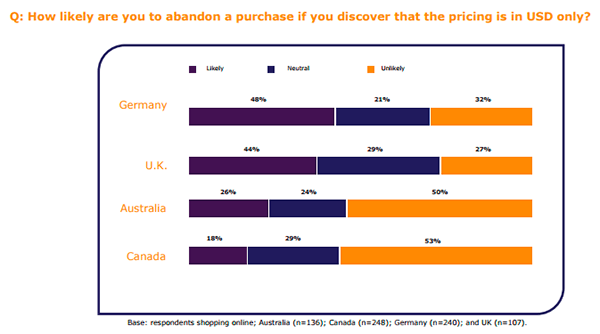For a global brand, it’s not enough to have content such as press releases, brochures and product descriptions available in multiple languages. There are many other important elements which need to be considered when localising a website, and the translation itself is not the biggest challenge.
It’s one thing to translate a piece of content, but it’s a completely different matter to make your entire website and e-commerce platform relevant for multiple locales. Suddenly, you’ll need to consider factors like varying units—should you use the imperial system’s inches, feet and miles, or the metric system’s centimetres, metres and kilos? You’ll also need to make a choice regarding temperature—should it be measured in Fahrenheit or Celsius? E-commerce solutions also require you to decide which currencies should be used for your products.
In this article we’ll look at the pros and cons the 3 main foreign currency pricing strategies for online shops; “One Currency”, “Floating Prices” and “Fixed Pricing”.
Pricing problems

Local Currency Pricing for eCommerce — Penton Research and E4X
Ideally prices are shown in the local currency, as online shops may lose potential customers otherwise. To demonstrate this, a study from Penton Research and E4X found that a third of shoppers showed their aversion for USD-only pricing by either abandoning carts, purchasing less, leaving the site to check conversion rates or even leaving and never returning to the website! Ask any e-commerce manager and they will tell you that this is unacceptable.
It might sound simple to fix this, but in practice you have to consider the problems concerning currency exchange rates and uncomplicated prices. Basically, an online shop can choose between the following 3 options:
1. One Currency

Is it enough to have prices in euro?
By sticking to one currency you pass any conversion work over to your customers. For example, a business based in France could have all its prices in Euro, and then pass the amount in Euro to PayPal or a credit card company and let them charge the customers in their local currencies. When internet shopping was in its infancy, having online shops in the business’ local currency was the norm. This is also the simplest method and it doesn’t come with any huge implementation costs.
But there are drawbacks. Firstly, it can cause confusion for customers not familiar with the shop’s currency. The customers may be unsure of the real cost and feel discouraged from making an immediate purchase. If they remain interested, the extra conversion step is one more purchasing barrier, something which online shops take great pains to avoid. Additionally, this approach might reduce trust in the brand. When the product isn’t priced in your currency, can you expect customer service for your locale if something goes wrong? And if something really does go wrong, will you even be able to get your money back? Nowadays, this method should be avoided as consumers will most probably see it as a riskier and more complex exchange when products are priced in a foreign currency.
2. Floating Pricing

Sticking to charm prices with floating pricing is tricky
Dynamically localising relevant currencies, normally for the countries you ship to, is also a popular online pricing method. When using this, the source price is constantly updated to the equivalent in the customer’s local currency, usually on a daily basis. This reduces uncertainty for customers regarding cost, but adds confusion in other areas.
One problem with this method is that it can be a pain for customer service. Customers normally take time to purchase something; they may bookmark a product or add it to their basket and wait a few days before completing their purchase. If the price increases during this time, it’s understandable that the customer becomes annoyed. You don’t want to be playing the foreign exchange market game while purchasing consumer goods, right? Another issue is that prices won’t land on so-called “charm prices” most of the time. Charm prices are the reason for all the 9s you often see at the end of a price. It’s a psychological trick to make customers underestimate costs and spend more (here’s a great video explainer on the topic from BrainStuff). So if you’re using floating prices, you’ll find making them stick to charm prices a tricky task.
3. Fixed Pricing

Mykita uses fixed pricing
The method most online shops use is fixed pricing for local currencies. Mykita, a trendy eyewear brand operating out of Berlin, is a good example of a shop that uses fixed, local pricing. Their products can be bought in USD in the US, EUR in the EU, GBP in the UK, DKK in Denmark as well as various other currencies. This doesn’t mean that prices aren’t adjusted at all, just that they don’t change on a daily basis. Occasional updates are made to prices when the RRP of collections are adjusted in the relevant markets.
You might wonder how currency shifts could negatively affect this strategy. Fortunately, exchange rates don’t suffer from massive, long-term changes on a day-to-day basis. Your regional stock might be purchased by local distributors to cover for any changes. Alternatively, you could add a small premium on your foreign currency price in order to cover for any negative changes and the extra administration costs.
To make it even easier for the customer, you can detect the users’ country through their IP address and show the price in the currency of their region. But make sure you offer the ability to switch, as it can be quite frustrating doing some online shopping while travelling abroad and not being able to change the country of purchase.
What's in your basket
The world of online shopping has come a long way since the 90s. Customers’ expectations for localised content and a smooth shopping experience have increased. With the increase in demands, any perceived friction in buying a product reflects badly on a brand.
Customers expect businesses to know who they are, what they want and to speak their language. For online shops, pricing is an important part of this. As shown earlier, customers are less likely to make a purchase if they have to deal with an unfamiliar currency. So make sure that your products are available in local currencies as part of your global marketing strategy.
